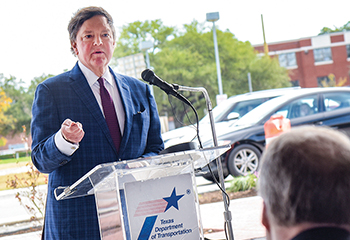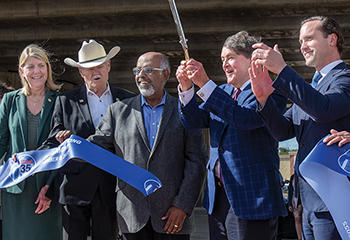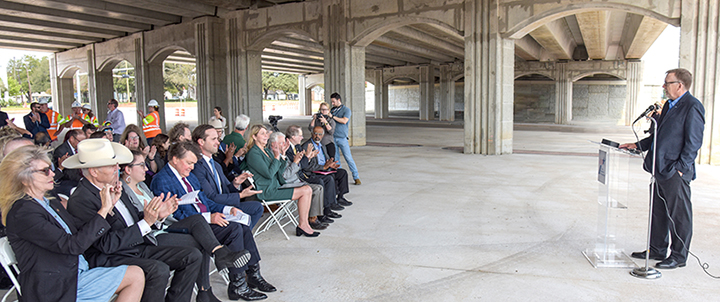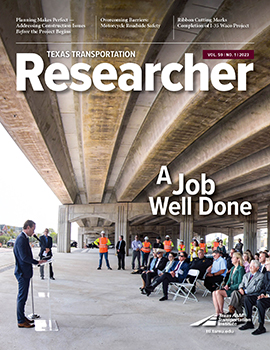The I-35 Waco Project is officially complete with a ribbon-cutting ceremony held Nov. 9. The $341 million project finished on budget and ahead of schedule, beating its originally estimated end date by approximately 18 months. The I-35 Waco Project is part of the larger My35 Waco District Construction Plan, begun in 2012, comprised of 17 separate construction efforts along a 96-mile corridor from Hillsboro to Salado in Central Texas.
Dignitaries from around the Lone Star State gathered under one of the project’s 21 newly constructed bridges to celebrate the formal opening of the roadway. Texas Department of Transportation (TxDOT) Waco District Engineer Stan Swiatek opened the ceremony, welcoming everyone and praising the interagency teamwork that made the construction effort so successful. “This project is one of the most complex the Waco District has ever undertaken,” Swiatek said. “But we did it!”


Begun in spring 2019, the project entailed TxDOT’s partnering with greater Waco stakeholders to improve 12 directional miles of I-35 traveled by up to 140,000 vehicles per day. A few of the new features are expansion from three to four lanes (in each direction), 13 additional U-turns to facilitate access along the corridor, and new signalized and marked pedestrian and bicycle facilities. The Texas A&M Transportation Institute (TTI) helped TxDOT coordinate communications with local citizens and businesses during construction.
Texas Transportation Commission Chair J. Bruce Bugg reinforced Swiatek’s recognition of interorganizational cooperation, praising the fiscal responsibility and get-it-done attitude that brought the project in so far ahead of schedule. Bugg called the I-35 Waco Project “one of the most vital” roadway improvement projects in Texas, noting the crucial role Waco’s enhanced corridor will play in helping TxDOT meet its mission of “connecting you with Texas.”
The project team implemented a number of innovations to promote mobility and safety during construction. For example, a traveler information system, which included 15 live-streaming cameras (viewable 24 hours a day via YouTube), helped keep travelers up to date on the latest corridor events, like traffic slowdowns and crashes. Other communication channels included a district newsletter, Twitter feed, real-time map, email updates and text messages.
The project also evolved, adding needed features as they were identified. Baylor University and Waco have grown in the last decade — and have grown together symbiotically. As a result, students often cross I-35 between the university and downtown, and that required adding a focus on bicyclist and pedestrian safety. To highlight new safety enhancements, TxDOT implemented the Be Safe Be Seen campaign to increase awareness. New pavement decals were placed in construction zones, for example, to ensure pedestrians and bicyclists were aware of new crossings.

At the ceremony, Waco Mayor Dillon Meek applauded local staff from his office, as well as the chamber of commerce and the Waco City Council. All parties working together, he said, helped keep the lines of communication open with local residents and businesses to ensure construction caused “as little difficulty as possible.”
Meek’s nod to keeping the community informed is representative of the larger My35 philosophy, which seeks community involvement early on to ensure the final product meets local mobility needs.
“Helping local folks participate in the process rather than simply having to suffer through the inconveniences of construction is part of the My35 philosophy of public engagement,” says TTI’s John Habermann, TxDOT’s mobility coordinator to local businesses and citizens.
This ribbon cutting was a cause for celebration for TxDOT. The Waco District’s population continues to grow, and commercial travel continues to increase. In the future, the district will maintain communication with its partners to study, plan and construct transportation infrastructure to promote safe travel to and through Waco. TxDOT is currently discussing the expansion of I-14, I-35 in south Waco, Texas 317 between Crawford and Temple, and Business 77. District staff are confident that once the projects come to fruition, staff will have a set of best practices in hand to guide these projects.
“So many things went right with this project,” Habermann says, “and even when the unexpected happened, our team was resilient in dealing with those challenges. Going forward, we have an excellent template for achieving success in future projects.”

